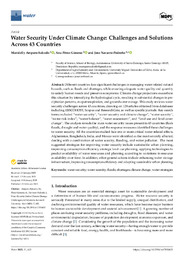Resumen :
Different countries face significant challenges in managing water-related natural
hazards, such as floods and shortages, while ensuring adequate water quality and quantity
to satisfy human needs and preserve ecosystems. Climate change projections exacerbate
this situation by intensifying the hydrological cycle, resulting in substantial changes in precipitation
patterns, evapotranspiration, and groundwater storage. This study reviews water
security challenges across 43 countries, drawing on 128 articles obtained from databases
including EBSCOHOST, Scopus and ResearchGate, as well as specific journals. Key search
terms included “water security”, “water security and climate change”, “water scarcity”,
“water risk index”, “water balance”, “water assessment”, and “land use and land cover
change”. The analysis reveals the main water security issues present in 43 countries (flash
floods, drought and water quality), and the response measures identified these challenges
to water security. All the countries studied face one or more critical water-related effects.
Afghanistan, Bangladesh, India, and Mexico were identified as the most severely affected,
dealing with a combination of water scarcity, flooding, and water pollution. The most
suggested strategies for improving water security include sustainable urban planning,
improving consumption efficiency, strategic land-use planning, applying technologies to
predict availability of water resources and planning according to variations in resource
availability over time. In addition, other general actions include enhancing water storage
infrastructure, improving consumption efficiency and adopting sustainable urban planning.
|
 La licencia se describe como: Atribución-NonComercial-NoDerivada 4.0 Internacional.
La licencia se describe como: Atribución-NonComercial-NoDerivada 4.0 Internacional.
.png)
